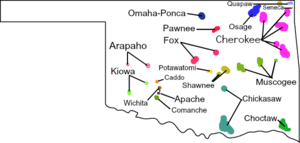Caddo language facts for kids
Quick facts for kids Caddo |
||||
|---|---|---|---|---|
| Hasí:nay | ||||
| Native to | United States | |||
| Region | Caddo County in western Oklahoma | |||
| Ethnicity | 45 Caddo people (2000 census) | |||
| Native speakers | 25 (1997) | |||
| Language family |
Caddoan
|
|||
| Linguasphere | 64-BBA-a | |||

Map showing the distribution of Oklahoma Indian Languages
|
||||
|
||||
Caddo is a special language spoken by the Caddo Nation, a group of Native American people. It's their traditional language. Sadly, very few people speak Caddo today. In 1997, only about 25 people still spoke it fluently. These speakers learned the language as children, not in school.
The Caddo language has several different ways of speaking, called dialects. These dialects are similar enough that speakers can usually understand each other. The most common dialects are Hasinai and Hainai. Other dialects include Kadohadacho, Natchitoches, and Yatasi.
Contents
Caddo's Language Family
Languages can be grouped into families, just like people. Caddo belongs to the Caddoan language family. This family includes other languages from Native American tribes.
- Some languages in the Caddoan family are Arikara, Kitsai, and Pawnee. These are sometimes called Pawnee-Kitsai languages.
- The Wichita language is also part of this family.
Sadly, Kitsai and Wichita are no longer spoken by anyone. Pawnee and Arikara also have very few speakers left. Caddo is working hard to keep its language alive.
Efforts to Save the Caddo Language
The Caddo Nation is working hard to save their language. They want to make sure it doesn't disappear.
- The Kiwat Hasinay ('Caddo Home') foundation helps with this. It is located in Binger, Oklahoma, where the Caddo tribe lives.
- They offer regular Caddo language classes for people who want to learn.
- They also create helpful tools like dictionaries and phrase books. These resources make it easier for people to learn and use Caddo words and sentences.
- A big project is recording and saving Caddo stories. These stories are an important part of Caddo culture and history. They are now stored digitally so they won't be lost.
- As of 2012, the Caddo Nation teaches weekly language classes.
- You can also find language CDs, a coloring book, and an online learning website.
- There's even a Caddo app for Android phones, available since 2010!
Experts have also written books about the Caddo language. A grammar book was published in 2018. Another book from 2004 looks closely at how Caddo verbs work.
Sounds of Caddo
Every language has its own unique sounds. Caddo has some interesting features in how it sounds.
Caddo Consonants
Caddo has 19 different consonant sounds. This is a normal number for a language. One interesting thing about Caddo is that it doesn't have "liquid" sounds like 'l' or 'r'.
Caddo also uses something called gemination. This means a consonant sound is held for a longer time. It's like saying a double letter in a word. For example, the word for "woman" sounds like /nɑ́ttih/, where the 't' sound is held longer.
Caddo Vowels
Caddo has three main vowel sounds: /i/, /ɑ/, and /u/. These are like the vowel sounds in English words such as "see," "father," and "flute."
Each of these vowel sounds can be either short or long. This means Caddo has a total of six different vowel sounds. The length of a vowel can change the meaning of a word.
Caddo also has four diphthongs. These are sounds made by combining two vowel sounds that glide together. They are:
- ay (like the "eye" sound in English)
- aw (like the "ou" sound in "out")
- iw (like the "ew" sound in "few")
- uy (like the "oy" sound in "boy")
Caddo Tones
Caddo is a tone language. This means that the pitch of your voice when you say a word can change its meaning. For example, saying the same word with a high pitch might mean one thing, while saying it with a low pitch means something else.
Caddo has three main tones:
- Low tone: This is the normal pitch and is not marked.
- High tone: This is a higher pitch, marked with an accent mark over the vowel (like á).
- Falling tone: This pitch starts high and goes low. It's always on a long vowel and marked with a grave accent (like àː).
Tone is important in Caddo. It can be part of the word itself, or it can be added to show things like past tense. For example, the past tense often uses a high tone.

